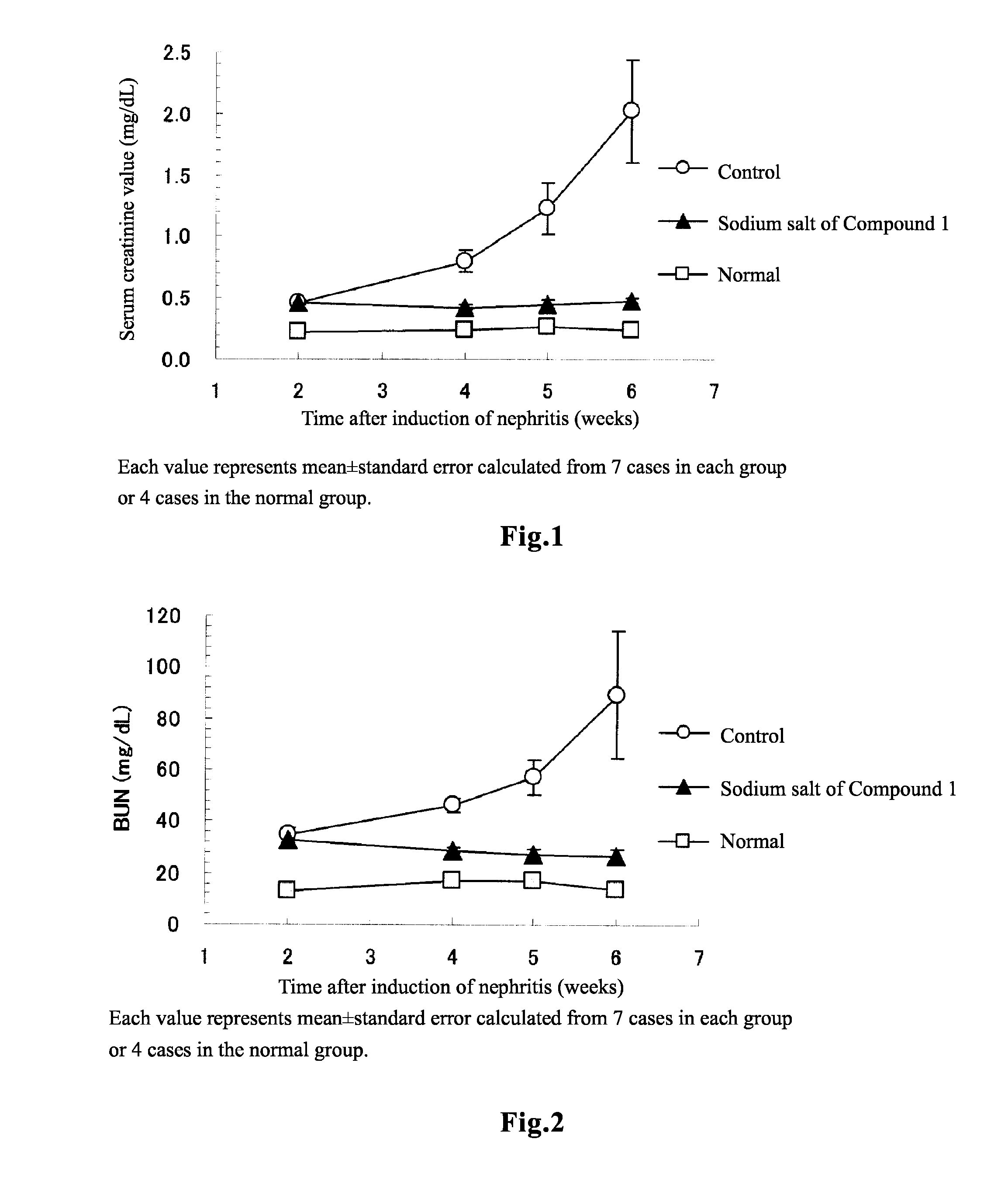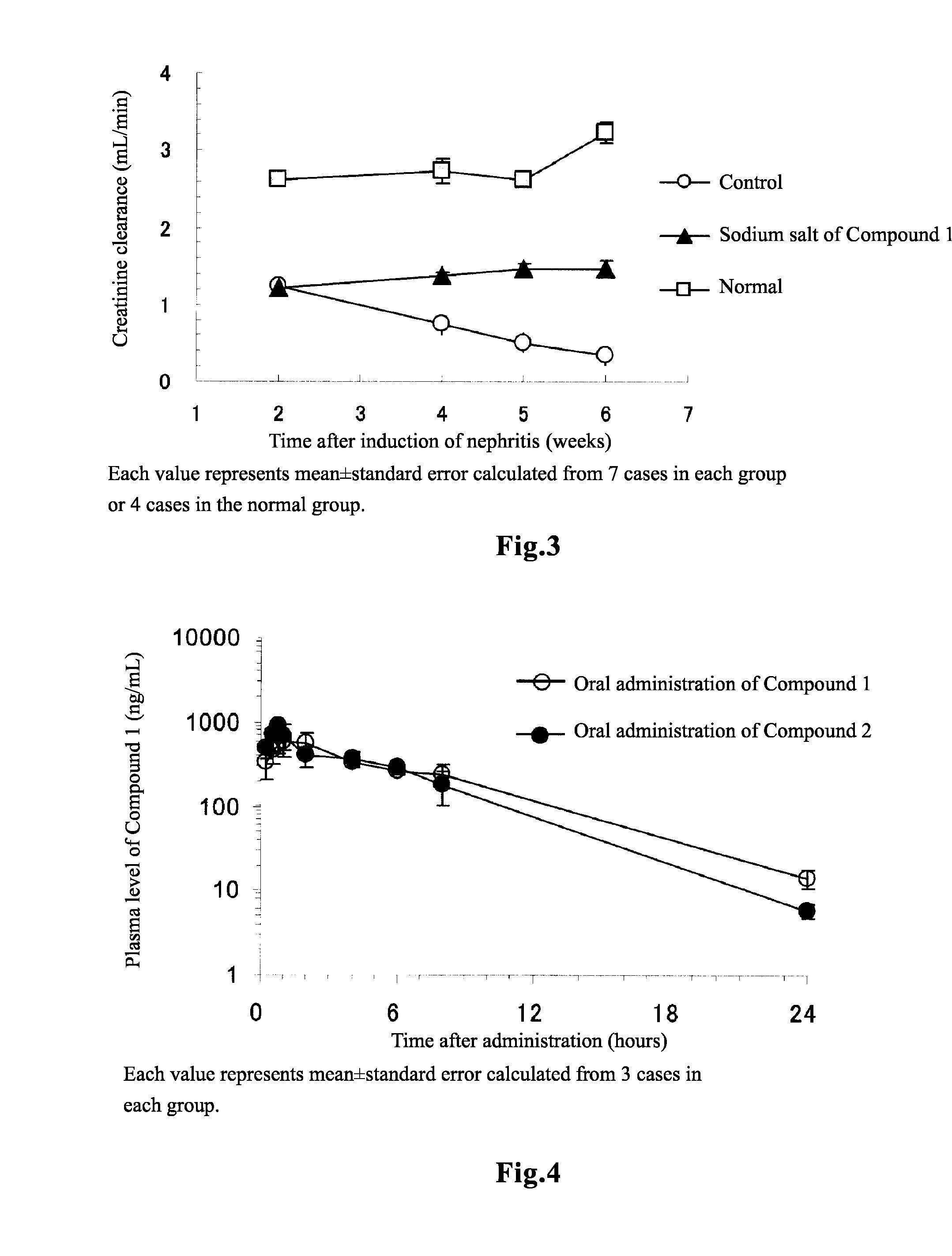Therapeutic agent for chronic renal failure
a technology for chronic renal failure and therapeutic agents, applied in the direction of drug compositions, organic chemistry, extracellular fluid disorder, etc., can solve the problems of inability to maintain the quantitative and qualitative homeostasis of body fluids, inability to establish chronic renal failure for a long period of time, and difficulty in pathological diagnosis of underlying diseases, etc., to achieve recovery function, improve anemia, and reduce the effect of renal function
- Summary
- Abstract
- Description
- Claims
- Application Information
AI Technical Summary
Benefits of technology
Problems solved by technology
Method used
Image
Examples
example 1
Platelet Aggregation Inhibition Action in Rat
(Experimental Method)
[0129]To determine the dose with which the PGI2-receptor agonistic activity is equivalent between the sodium salt of Compound 1 and beraprost sodium, the platelet aggregation inhibition action which is the major pharmacological action of PGI2-receptor agonists was used as an index for comparison. The sodium salt of Compound 1 (30 mg / kg) or beraprost sodium (0.3 mg / kg) was orally administered to rats fasted for 1 day, and blood was collected therefrom at the time when the plasma level of each compound became maximum, that is, 1 hour after the administration of the sodium salt of Compound 1 (Non-patent Document: J Pharmacol Exp Ther 322:1181-1188 2007) or 0.5 hour after the administration of beraprost sodium (Non-patent Document: Xenobiotic Metabolism and Disposition 6:713-725 1989), followed by measuring ADP-induced rat platelet aggregation. In the both groups, the experiment was carried out with n=6. The sodium salt o...
example 2
[0131]Pharmacological Effect in Rats Suffering from Chronic Renal Failure
(Experimental Method)
[0132]Rabbit anti-rat glomerular basement membrane antiserum (14-fold diluted, 3 mL / kg) was intravenously injected to WKY rats of 8 weeks old, to induce glomerulonephritis. Two weeks after the induction of nephritis, blood was collected, and it was confirmed that the serum creatinine value has been significantly increased at this time and hence that chronic renal failure has already occurred (normal group: 0.23±0.01 mg / dL, N=4; nephritis-induced group: 0.47±0.01 mg / dL, N=21; t test). Further, creatinine clearance, which is used as an alternative to glomerular filtration rate (GFR), was 2.63±0.07 mL / min. (N=3) in the normal group, and 1.22±0.04 mL / min. (N=21) in the nephritis-induced group. That is, creatinine clearance in the nephritis-induced group decreased to not more than 50% with respect to that of the normal group, and therefore it was confirmed that the nephritis-induced group develo...
example 3
[0142]Changes in Plasma Level of Compound 1 with Time after Administration of Compound 1 and Compound 2 to Rats
[0143]Compound 1 or Compound 2 was orally administered to rats in an amount of 5 mg / kg, and Compound 1 was intravenously administered in an amount of 1 mg / kg, after which the concentration of Compound 1 in plasma was measured. The experiment was carried out with n=3 in each of the both groups. Compound 2 was converted to Compound 1 in the living body, and the bioavailability was not statistically different from that in the case of direct administration of Compound 1 (Table 5), showing overlapping changes in the plasma level of Compound 1 between these cases as shown in FIG. 4. Thus, it was shown that Compound 2 can be used in a manner similar to Compound 1. Compound 1 and Compound 2 used in this experiment was synthesized in accordance with the method described in Patent Document 4.
TABLE 5Bioavailability observed upon administration ofCompound 1 and Compound 2 to ratsCompou...
PUM
| Property | Measurement | Unit |
|---|---|---|
| time | aaaaa | aaaaa |
| organic | aaaaa | aaaaa |
| oxidative stress | aaaaa | aaaaa |
Abstract
Description
Claims
Application Information
 Login to View More
Login to View More - R&D
- Intellectual Property
- Life Sciences
- Materials
- Tech Scout
- Unparalleled Data Quality
- Higher Quality Content
- 60% Fewer Hallucinations
Browse by: Latest US Patents, China's latest patents, Technical Efficacy Thesaurus, Application Domain, Technology Topic, Popular Technical Reports.
© 2025 PatSnap. All rights reserved.Legal|Privacy policy|Modern Slavery Act Transparency Statement|Sitemap|About US| Contact US: help@patsnap.com



